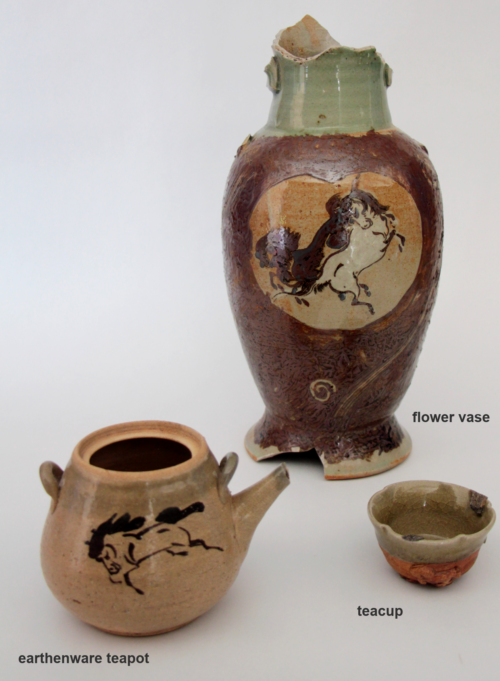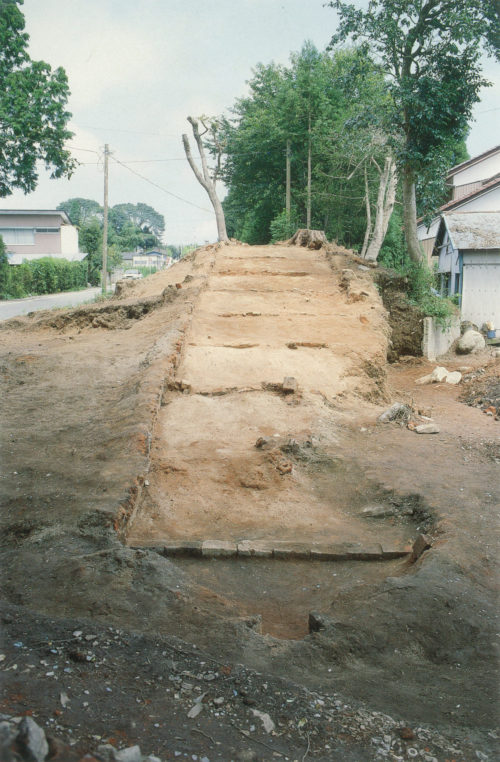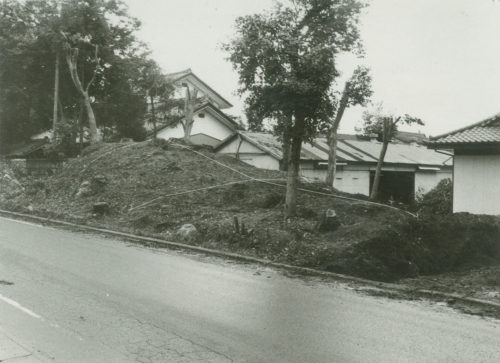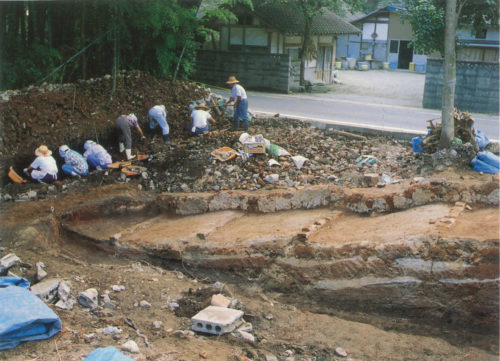Namie Town, Fukushima Prefecture
Meiji–Taishō periods (nineteenth–twentieth centuries)

Earthenware teapot, flower vase, teacup Ōbori Sōma ware increased in variety from the Meiji period into the Taishō and Shōwa eras. A running horse is often painted or applied with a stamp as the characteristic design of Ōbori Sōma ware on small teacups, on earthenware teapots with a shape typically bulging at the bottom, and on vases for Buddhist offerings of flowers, while items bearing a celadon glaze with blue cracks on the surface are also seen, and the production of these varieties is still being carried on. Flower vase: rim diameter is unclear, foot diameter is 13.1 cm, and surviving vessel height is 32.6 cm. Earthenware teapot: rim diameter is 7 cm, foot diameter is 7.4 cm, and vessel height is 9.7 cm. Teacup: rim diameter is 7.6 cm, foot diameter is 3.9 cm, and vessel height is 4.3 cm. Adapted from Hakkutsu sareta Nihon rettō 2019 [Excavations in the Japanese Archipelago, 2019] (Bunkachō [Agency for Cultural Affairs], ed., Kyodo News, 2019).

Panorama of the Ōbori Nagaiya kiln site (from the southwest) The fire box in the foreground is approximately 35 cm wide by 30 cm deep. This is followed by the abruptly widening triangular combustion chamber, a series of eight firing chambers, the stabilizing chamber (sutema), and the chimney.

The Ōbori Nagaiya kiln site immediately prior to investigation (from the west) At a level surface on the slope of a hill, earth was mounded to make a gentle incline of 13–15 degrees, on top of which the kiln was constructed.

Firing chambers and waster dump (from the east) The firing chambers are in the foreground. Three of the eight linked chambers are visible. The waster dump is toward the back of the photo. A place for discarding ash from the kiln and items that broke or were ruined during firing, the dump yielded large amounts of ceramics.
An Ōbori Sōma ware kiln site that continued from the Edo period
Early Modern period technology of kiln operations is carried on
The Ōbori Nagaiya kiln site is the remains of a kiln producing Ōbori Sōma ware from the Early Modern to the start of the Modern periods. It was built on the level top of a river terrace extending from the Abukuma Highlands towards the Pacific Ocean at an elevation of 38–40 m along the northern bank of the Takase River. It was the second excavated example of a kiln site producing Ōbori Sōma ware, following the Yamakami kiln site located in Ōkuma Town, and is an important site for clarifying the conditions of production and transitions of Ōbori Sōma ware.
Ōbori Sōma was mainly a ware for ordinary use produced in commercially operated private kilns, with a history going back to the Genroku era (1688–1704). It was begun by a retainer of the Sōma samurai clan named Hangai Kyūkan and his servant Sama, and from the Late Edo to the Bakumatsu periods there were more than 100 kilns operating in Ōbori and other villages in its environs.
The Sōma domain placed Ōbori Sōma ware under its protection and control, and through its efforts at promoting the popularization of the ware and the development of specialty items, and at aggressively expanding the sales routes, products circulated widely from the Tōhoku region to Edo itself. After the Meiji Restoration, the industry continued production after gaining an independent footing, and in 1978 it was nationally designated by the Minister of Economy, Trade and Industry as a Traditional Craft, and has since been making efforts to secure and train successors, and convey thereby the traditional methods and techniques.
Following the Great East Japan Earthquake, the Ōbori district which was the region of production for Ōbori Sōma ware fell for the most part within the exclusion zone, where residents’ return is expected to remain difficult for some time, so all of the kiln operators were forced to evacuate, but in their places of refuge each has reopened independently, and this unique culture is being carried on. (Koizumi Hiroaki)

